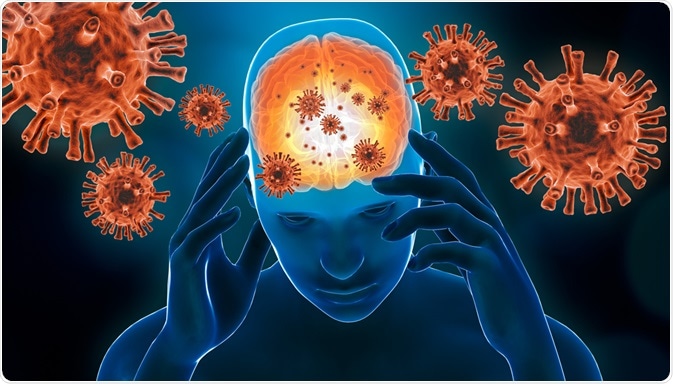By definition, encephalitis is the inflammation of the brain. The causes of infectious encephalitis can be viral, bacterial, fungal, protozoal, or helminthic; however, about 70% of encephalitis cases are viral in etiology.

Image Credit: MattLphotography/Shutterstock.com
Types of encephalitis
Encephalitis can be characterized as either primary or secondary. Whereas primary encephalitis arises when a virus or other type of agent directly infects the brain, secondary encephalitis is due to an altered immune response that causes the immune system to mistakenly attack healthy cells in the brain.
Viral
About 70% of encephalitis cases are viral in etiology, with herpes simplex virus (HSV) being the most common cause of viral encephalitis in the world.
In addition to HSV, several other ubiquitous human viruses cause encephalitis in immunocompetent adults, of which include a varicella-zoster virus, enteroviruses, adenoviruses and the measles virus.
In addition to these human viruses, several zoonotic viruses can also result in encephalitis, of which include tick-borne encephalitis virus, West Nile virus, Sandfly fever Naples viruses, Usutu virus, rabies virus, and variegated squirrel bornavirus 1.
Autoimmune
Infectious encephalitis can also arise from various autoimmune conditions that cause antibodies to be produced against neuronal surface antigens. Anti-N-methyl D-aspartate receptor (NMDAR) encephalitis, for example, is one of the most common types of autoimmune encephalitides that causes women with ovarian teratomas to experience both psychiatric and neurologic symptoms.
Other types of autoimmune encephalitides include LGI-1 antibody encephalitis in patients with thymoma, anti-Hu that arise when a patient has small cell lung tumors, anti-Ma antigens that are associated with testicular tumors, acute disseminated encephalomyelitis and Bickerstaff’s encephalitis.
Other causes
Some of the primary causes of infectious encephalitis outside of viral causes include bacterial meningitis, tuberculosis, systemic sepsis with encephalopathy, and certain aggressive infections in immunocompromised patients, such as cryptococcus, toxoplasma, and cytomegalovirus.
Encephalitis can arise in patients with neuropsychiatric systemic lupus erythematosus (NPSLE), Behcet’s disease, neurosarcoidosis, and vasculitis. Primary brain tumors, particularly low-grade gliomas and metastases to the brain can also be neoplastic causes of encephalitis.
Hypoglycemia, hyponatremia, hepatic encephalopathy, ischemic and/or hemorrhagic stroke, and the overdose of certain drugs and/or alcohol can also lead to encephalitis.
Patient history
When a potential encephalitis patient is presented, the most common neurological symptom is confusion. Although patients of any age can develop encephalitis, young children and older adults are often at higher risk of the most common types of encephalitis.
Individuals with compromised immune systems, such as those with HIV/AIDS or who are taking immune-suppressing drugs, are also at a greater risk of encephalitis.
To determine possible causes of the patient’s altered neurological state, the treating clinician will obtain an initial history that will inquire about whether the patient has experienced any personality or behavioral changes, periods of drowsiness, or seizures.
Additionally, a travel history detailing whether the patient has been in contact with any animals, freshwater, mosquitos, ticks, or other foreign illnesses should also be obtained. Since mosquito- or tick-borne viruses are common in certain areas of the globe, obtaining a recent travel history is crucial.
Diagnosis
The diagnosis of encephalitis can only be determined when both encephalopathy and central nervous system (CNS) inflammation is present. Encephalopathy is defined as a period of altered consciousness that persists for more than 24 hours.
During this period, patients with encephalopathy will experience lethargy, irritability, and other changes in their personality and/or behavior.
In addition to encephalopathy, CNS inflammation in encephalitis patients is demonstrated by the presence of a fever, seizures, cerebrospinal fluid (CSF) markers, and electroencephalography (EEG) or neuroimaging findings that are suggestive of encephalitis.
CSF fluid
Once the patient’s history has been obtained, CSF fluid that has been acquired from a lumbar puncture is analyzed. Typically, a patient with encephalitis will have an elevated white blood cell count between 6 and 1000 G/L in their CSF.
Additional CSF findings that can lead to a diagnosis of encephalitis include proteinorachia, as well as the presence of lymphocytes and, to a lesser extent, monocytes and neutrophils.
Whereas all encephalitis patients will typically have normal glucose levels present in their CSF fluid, it should be noted that approximately 10% of infected patients will present with normal CSF studies.
Other techniques
In addition to patient history and CSF fluid analysis, real-time reverse transcription-polymerase chain reaction (rRT-PCR) is considered to be the reference standard diagnostic test for infection-related encephalitis, particularly when a virus origin is suspected.
Additional serology testing for the presence of IgG and IgM antibodies can also assist in an encephalitis diagnosis. Rarely, a brain biopsy can be performed; however, this diagnostic test will only be used if symptoms continue to worsen despite the patient receiving treatment.
Treatment
The origin of a given encephalitis diagnosis will determine the appropriate treatment option. Viral encephalitis, for example, can be treated with certain antiviral medications; however, the specific virus will determine whether these common drugs will be effective in reducing the neurological effects of the virus. Many insect-borne viruses, for example, do not respond to conventional antiviral drugs.
Aside from the viruses that can be eradicated by these antiviral drugs, encephalitis treatment is largely supported.
To this end, patients with encephalitis of other etiologies may require breathing assistance, intravenous fluid administration to maintain adequate hydration and electrolyte levels, anti-convulsant medications to stop or prevent seizures, and anti-inflammatory drugs to reduce intracranial pressure.
References and Further Reading
- Ellul, M., & Solomon, T. (2018). Acute encephalitis – diagnosis and management. Royal College of Physicians Clinical Medicine 18(2); 155-159. doi:10.7861/clinmedicine.18-2-155.
- Schibler, M., Eperon, G., Kenfak, A., Lascano, A., et al. (2019). Diagnostic tools to tackle infectious causes of encephalitis and meningoencephalitis in immunocompetent adults in Europe. Clinical Microbiology and Infection 25; 408-414. doi:10.1016/j.cmi.2018.12.035.
- Ford, B., McDonald, A., & Srinivasan, S. (2019). Anti-NMDA receptor encephalitis: a case study and illness overview. Drugs in Context 8. doi:10.757/dic.212589.
- “Encephalitis” – Mayo Clinic
Further Reading